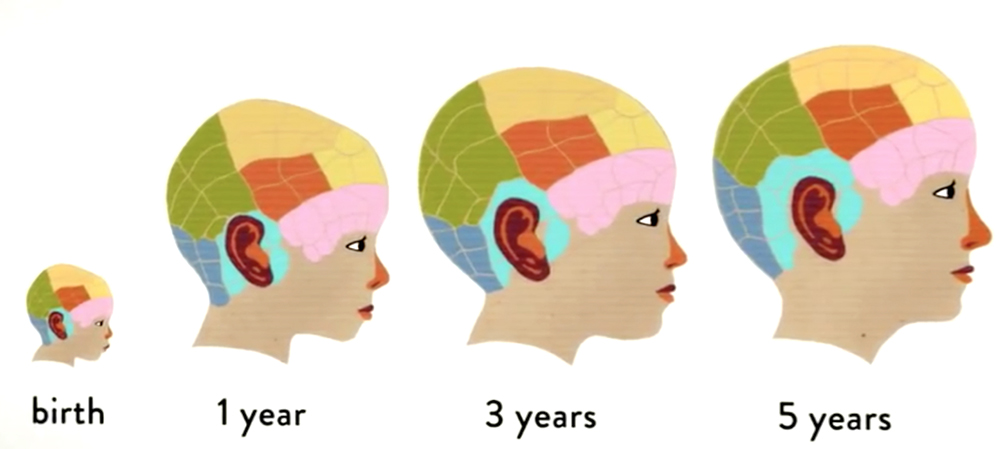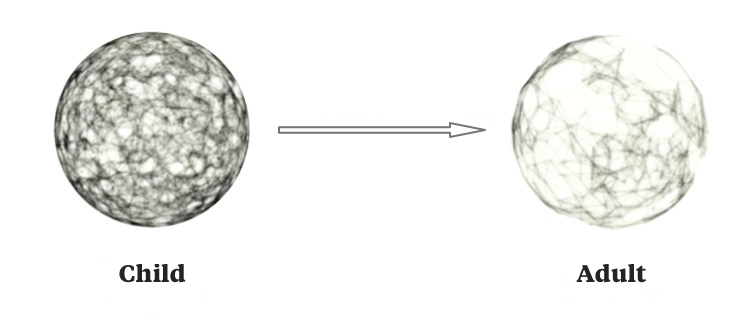Plasticity – for better or worse.
The newly born human being begins to store up information from the external world through the channel of the senses. Each image, each interaction and each event, however routine, fixes itself in the fibres of the brain by connecting up neurons. These neural connections start to be established in the mother's womb and then proliferate extremely rapidly after birth: 700 to 1,000 new connections are created every second during the first five years of life.

Just as the stonemason begins by laying the foundations when building a house, so the human brain starts by creating thousands of connections in order to structure itself. In other words, this period when the brain is highly sensitive to impressions is fundamental because it lays down the first stones of the temple of intelligence. And as ever, nature is well designed – just at the time when the brain requires this proliferation of neural connections in order to begin structuring itself, the young child is driven by a strong passion for exploring. Even as they touch and grab things, call out to us, watch us and observe the world intently, their brain is constructing itself and it is essential that we adults do not put up systematic barriers to this formative urge, hampering it for own comfort or for the child's safety: 'don't touch that', 'stay there', 'sit down', 'wait for me', 'be quiet' etc. When we do so, it is not the child whom we are constraining but their intelligence which is in the process of forming. Let's allow the intelligence to explore and to create many billions of connections.
Yes, billions.
We can give ourselves an idea of the scale by comparing the child's brain to the world wide web. When two neurons connect up, it is called a synapse. When two web pages connect up, it is called a hyperlink. Which one has the most connections? The internet or the child's brain? The web obviously contains a mind-boggling number of connections (100,000 billion hyperlinks). But prepare yourself for a surprise: the adult brain contains three times as many (300,000 billion synaptic connections) and the child's brain has 10 times more connections than the web: 1 million billion synaptic connections. Everything that the child perceives in his or her environment - absolutely everything - creates a connection.

The human brain therefore literally structures itself from its environment. An environment which is unstimulating or violent would therefore have dramatic structural repercussions during this period, given that the brain structures itself from what it receives. And if what it receives is limited, it develops poorly. The tragedy of the orphans of Bucharest illustrates this point well. After the fall of the Romanian dictator Nicolae Ceaușescu, the atrocious conditions in state orphanages came to light. Babies were left on their own for hours at a time in beds with bars; there were several of them to a bed and sometimes they were entirely deprived of daylight. Their contact with adults was reduced to a minimum: one carer was responsible for the feeding and hygiene of 20 children, but that was her only interaction with them. The human brain, if deprived of the outside world when it should be nourished by it, does not develop correctly – it does not even reach a normal volume. Although physically well-fed on a daily basis, these children were suffering from a genuine mental famine. It goes without saying that a lack of stimulation during this period damages a person's potential – just as fragile foundations undermine the stability of a house, so weak neural circuits created by a baby impair the brain architecture of the future adult self. During this initial period of life, the brain nourishes itself on the world. And so we should offer it the world.
The sorting stage.
Having created its 1 million billion connections, and in the process pipping the world wide web at the finishing post, the human brain starts to do some tidying. Remember that growing up involves going from 1 million billion synapses to 300,000 billion. The least used connections, which encode the least often repeated experiences, will gradually become weaker and be eliminated. In contrast, the most often used connections, which encode the experiences which the child has most often, will be reinforced. This is called synaptic pruning. But the key point is that when the brain is doing its synaptic pruning, it pays no attention to the nature of what it is erasing: it sorts according to frequency. If a child has been most frequently exposed to very informal vocabulary, even if they sometimes hear people expressing themselves in more formal language, the brain will reinforce the trace of the words they hear most often.

Growing up thus involves losing two thirds of one's possibilities and reinforcing the most used third. A study has shown that, at the age of 9 months, the child's brain still responds to all the sounds of all the world's languages when it is exposed to them. But by the age of 12 months, the human brain will only react to the sounds of the language of its environment. As well as being precocious, nature is a strict timekeeper: the superpowers are in place at 9 months but are gone at 12 months – the child can no longer hear the sounds of all the world's languages and instead becomes a specialist in their own. Growing up involves specialising. Adults are not less intelligent, but they are more specialised: specialised in their language, their culture, their thought processes, their social behaviours, etc. And living with a child involves participating in their specialisation. Our ways of speaking and reacting, and what we do with them and in front of them, will quite literally play a role in wiring their brain.
Age 0-2: a critical period
At the age of 1, then, the brain has already carried out some radical pruning. A year later, at the age of 2, it has prepared the foundations of its own architecture, based on its most frequent experiences, whether they be positive or negative. These fundamental structures subsequently become increasingly difficult to rewire. The studies in Philadelphia and Bucharest bear this out: although resilience is still possible if the child's environment is changed before they reach the age of two (even if they have experienced extreme circumstances), it is much more difficult if the child's environment is changed after they are two. In the latter case, there can be serious and lasting repercussions. Naturally the brain continues to evolve and to create new connections throughout life, but in most cases it will have to contend with the quality of the foundations which were laid down in very early childhood. It is therefore crucially important to pay special attention to this critical period before the child's brain becomes too specialised.
And so what is brain plasticity exactly?
It is the continuous and dynamic process of creating, reinforcing and eliminating synaptic connections. This process begins prior to birth and continues very vigorously in the early years of life, during which time it lays the foundations of the brain's architecture. After this period, plasticity gradually diminishes and falls very sharply at puberty, although the brain does retain some plasticity in adulthood. The brain never ceases to create new circuits, and that is just what it is doing now as you read this text.
What are the important points to retain?
That the brain possesses amazing capacities, but powerful though its plasticity is, it is moulded by its external environment. This means that the early stages of life are both a period of great opportunity and great vulnerability: every experience counts, whether it be positive or negative. And this gives rise to a social imperative: we adults have a responsibility to furnish the newly born human being with an environment which offers them the best and protects them from the worst.
Further reading
Center of the Developing Child - Harvard University
Fondements cognitifs des apprentissages scolaires - Collège de France.
Éducation, plasticité cérébrale et recyclage neuronal - Stanislas Dehaene.
Brain power: From Neurons to Networks - Tiffany Shlain (a TED book)

